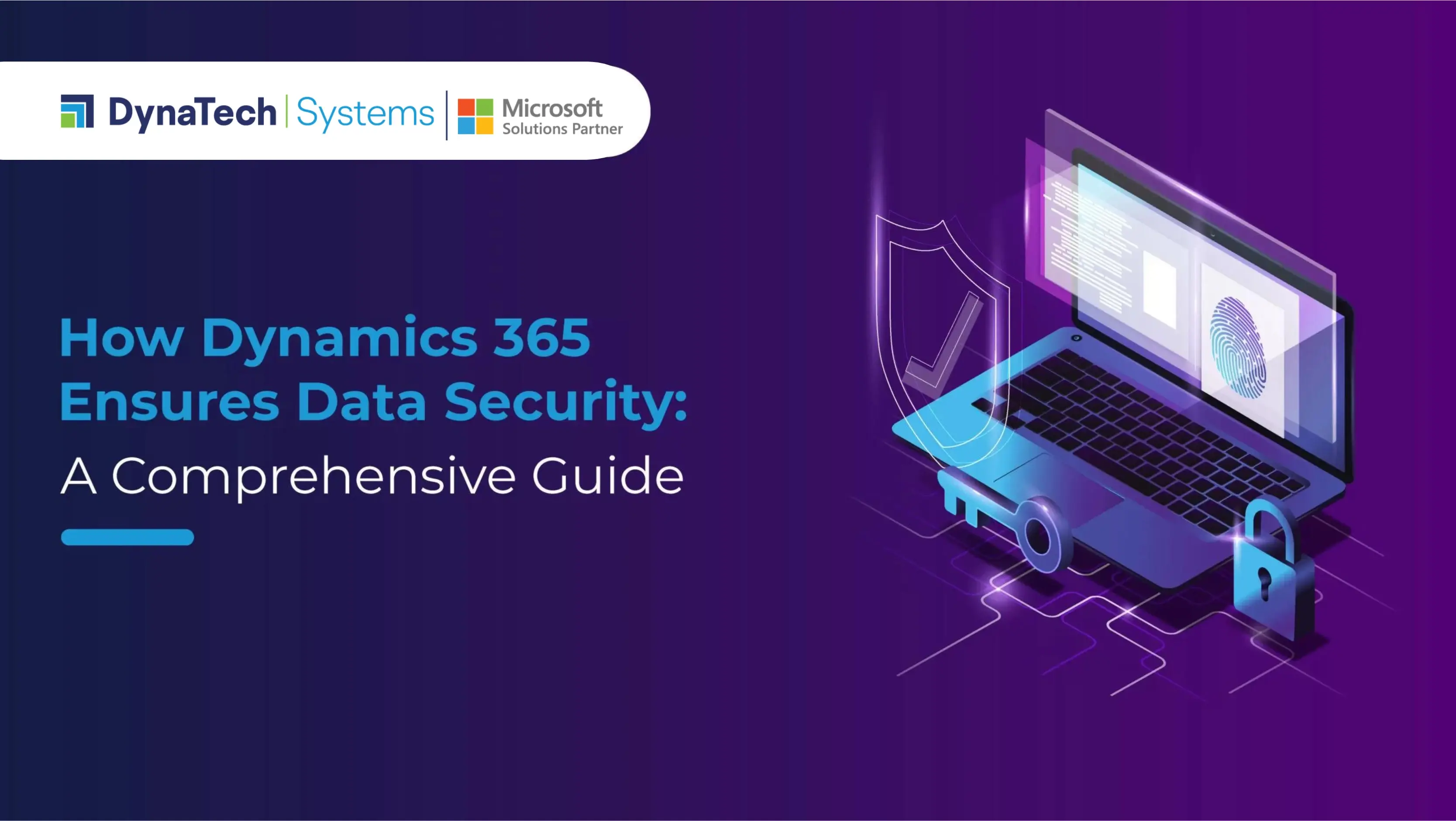In the age of digital transformation, businesses rely heavily on data to drive their operations, make informed decisions, and deliver exceptional customer experiences. As data becomes more critical, ensuring its security is of utmost importance. Microsoft Dynamics 365 – a powerful suite of business applications, offers robust data security measures to protect your sensitive information.
In this comprehensive guide, we will explore the various aspects of how Dynamics 365 ensures data security, from encryption and authentication to compliance and monitoring.
Microsoft Dynamics 365: Your Data Security Partner
Before we dive into the specifics of data security, let’s briefly introduce Dynamics 365.
Dynamics 365 is not just another software suite; it’s an agile platform equipped with the latest Azure technology. It empowers organizations to tailor their security models to meet their unique needs. While offering universal Dynamics 365 Security Tool and functions as part of its service, Dynamics 365 goes the extra mile by providing a range of additional security layers that can be easily configured.
This level of security is challenging to achieve internally and is made possible due to the integration with Microsoft Cloud technology.
Business Data Security with Dynamics 365 and Microsoft Technology
In this section, we will explore the layers of encryption and authentication that Microsoft has implemented to safeguard your data in the cloud. We will also dive into how security roles and privileges offer granular control over data access within Dynamics 365. Additionally, we will discuss the proactive steps you can take to further fortify your data security.
How Microsoft Protects Your Data?
While Microsoft is responsible for storing your data and implementing measures to protect it, you retain ownership of your data. Microsoft employs a multi-layered approach to ensure data security:
A. Encryption
Microsoft Dataverse, which securely stores and manages data from Dynamics 365 and other business applications, employs SQL Server Transparent Data Encryption (TDE) for real-time data encryption. Encryption Keys, managed by Microsoft, are essential for data access and are strongly recommended to be managed directly by Microsoft.
But Microsoft’s encryption prowess does not stop there; it extends to securing data transit. Connections between users and Microsoft data centers are encrypted using industry-standard Transport Layer Security (TLS), guaranteeing data integrity during transmission.
- Encryption Keys: Encryption keys are the linchpin of data security. Microsoft manages these keys to ensure the highest level of data protection. Administrators can access and self-manage these keys, but it is highly recommended to entrust Microsoft with their management.
- Secure Data Transit: Microsoft secures data during transit by encrypting connections between users and its data centers, relying on the industry-standard Transport Layer Security (TLS). This ensures data integrity during transmission.
B. Authentication
To access data, only authenticated users with specific user rights to Dynamics 365 are permitted. Dynamics 365 relies on Microsoft Azure Active Directory (Azure AD) to identify users, ensuring they have valid Azure AD accounts within the authorized tenant.
Additional authentication measures, such as conditional access and Multi-Factor Authentication (MFA), provide enhanced security by considering factors like user location and device used.
- Azure Active Directory (Azure AD): Dynamics 365 Online users must have a valid Azure AD account within the authorized tenant to access the platform. Azure AD accounts can be associated with other business applications, streamlining user access across various services.
- Conditional Access: Azure AD can enforce conditional access policies based on various factors, such as user location and the device used. Real-time risk detection enhances security by dynamically assessing whether access should be granted.
- Multi-Factor Authentication (MFA): MFA adds an extra layer of security by requiring users to provide additional authentication beyond just their username and password credentials. This helps thwart automated cyber-attacks and unauthorized access.
C. Dynamics 365 Security
Once a user successfully authenticates, Dynamics 365 employs a multifaceted security framework to control data access.
Security Roles: Granular Access Control
Security roles in Dynamics 365 are instrumental in regulating user access. They facilitate a granular approach to data access control:
- Business Units: Dynamics 365 utilizes business units to define the organizational structure. Each user is assigned to a specific business unit, but for finer security granularity, role-based security is recommended.
- Role-Based Security: Roles are pivotal in granting permissions to users based on their job responsibilities. Permissions include privileges like creating, reading, updating, and deleting records. Dynamics 365 provides predefined roles like “System Administrator” and “System Customizer,” but you have the flexibility to create and edit roles to align with your organization’s unique security needs.
- Teams: Teams enable the collective assignment of a security role. Any user added to a team inherits the security role associated with that team. This feature simplifies the management of permissions across users from different business units.
- Hierarchy Security: This model categorizes user access based on their position within the company hierarchy. It proves invaluable when managers require access to records or reports that typically fall outside their department’s purview.
D. Privileges: Fine-Tuning Access Permissions
Privileges within Dynamics 365 offer a high degree of flexibility in fine-tuning access permissions:
- Record-Level Privileges: These encompass eight privileges, including creating, reading, writing, deleting, appending, appending to, assigning, and sharing records. Users are granted these privileges based on their roles, and they can be shared with others.
- Field-Based Security: Field-based security allows restrictions to be applied to individual fields within a record. For instance, certain data may be masked or hidden based on user privileges.
- Task-Based Privileges: These privileges govern specific tasks within the system, such as bulk deleting, publishing reports, and viewing audit history. Task-based privileges enable organizations to maintain precise control over various aspects of the system.
Microsoft’s Vigilant Security Approach
Microsoft is determined in its commitment to preserving the security of its customers’ information. The company embraces an “assume breach” strategy, employing specialized security teams known as the Red Team. These experts continually test Microsoft’s enterprise cloud services through simulated breach scenarios, enhancing threat detection, response, and defense mechanisms.
To mitigate emerging threats, Microsoft maintains rigorous internal and external scanning regimens to identify vulnerabilities and assess patch management efficacy. Compliance audits ensure that baseline configuration templates are adhered to, and vulnerabilities are swiftly remediated.
All unused input/output ports on production servers are disabled, and intrusion detection mechanisms are activated to detect any physical server access.
Continuous Security Evolution
Microsoft adheres to the principles of separation of duties and least privilege throughout its operations. To facilitate customer support for specific services, Microsoft support personnel can access customer data only with explicit customer consent. This access is granted on a “just-in-time” basis, logged, audited, and revoked upon task completion.
Operational engineers and support personnel use specially provisioned workstation PCs equipped with Trusted Platform Modules (TPMs) and BitLocker-encrypted boot drives for corporate network access. These measures bolster physical and logical access control.
System hardening is orchestrated through group policies, while event logs, including security and AppLocker logs, are collected and centrally stored for auditing and analysis. Jump-boxes with two-factor authentication are employed to connect to production networks within Microsoft, ensuring secure access.
Data Security Best Practices in Dynamics 365
While Dynamics 365 F&O Security Management provides robust data security features out of the box, organizations can further enhance their data security by implementing best practices:
Tip #1: Regular Security Audits
Perform regular security audits to identify vulnerabilities and ensure that security policies and configurations are up to date. Audit logs in Dynamics 365 can provide insights into user activities and system changes.
Tip #2: User Training
Properly train your users on security best practices. Educate them on the importance of strong passwords, MFA, and recognizing phishing attempts. Well-informed users are your first line of defense against security threats.
Tip #3: Data Backup and Recovery
Implement a robust data backup and recovery strategy to ensure that your data is protected against data loss or ransomware attacks. Azure offers backup solutions that can be seamlessly integrated with Dynamics 365.
Tip #4: Stay Informed
Stay informed about security updates and patches for Dynamics 365. Microsoft regularly releases security updates to address known vulnerabilities. Keeping your system up to date is crucial for staying protected.
Tip #5: Third-party Security Solutions
Consider leveraging third-party security solutions that integrate with Dynamics 365. These solutions can provide additional layers of protection and advanced threat detection capabilities.
Bottom Line: Microsoft Dynamics 365 is more than just a suite of business applications; it’s a secure platform that allows organizations to operate with confidence. With its foundation in Microsoft Azure, advanced security features, and a comprehensive security model, Dynamics 365 ensures that your data is protected at every level. Additionally, by following the best practices listed above and staying vigilant, you can further enhance your data security and harness the full potential of Dynamics 365 for your business.
Choose DynaTech Systems for Dynamics 365
While Dynamics 365 is undeniably a powerful and secure solution, one crucial factor influencing your data security is the proper implementation of this solution. This is where DynaTech Systems comes into play.
As a Microsoft Solutions Partner, we possess extensive experience in this domain, backed by a robust team of over 250 experts globally. Moreover, we boast a gold-standard track record with over 180 successful projects to our name.
To begin your digital transformation journey, schedule a demo with our Microsoft Dynamics 365 experts today.




























